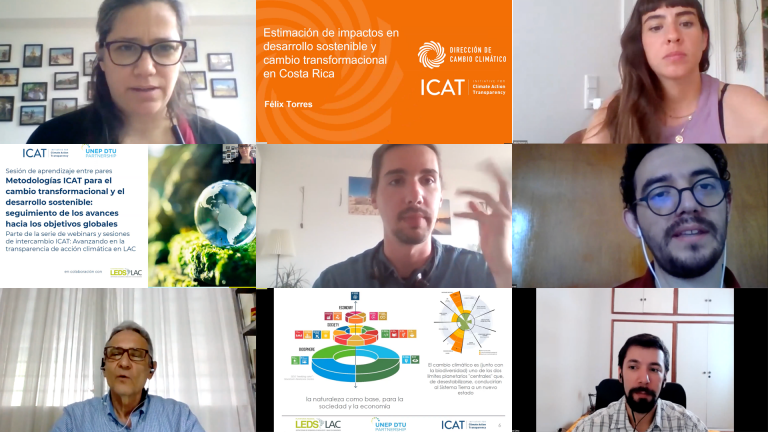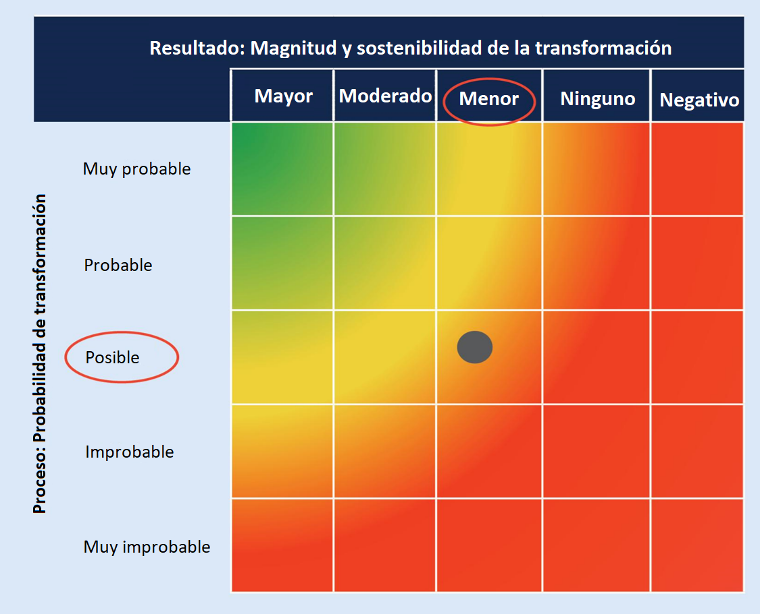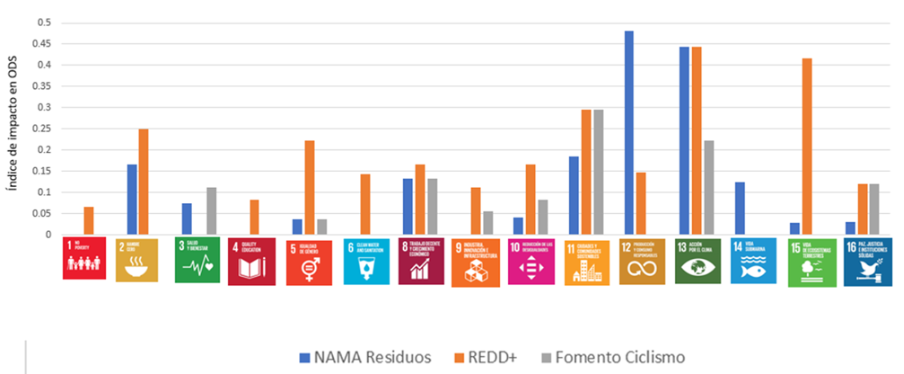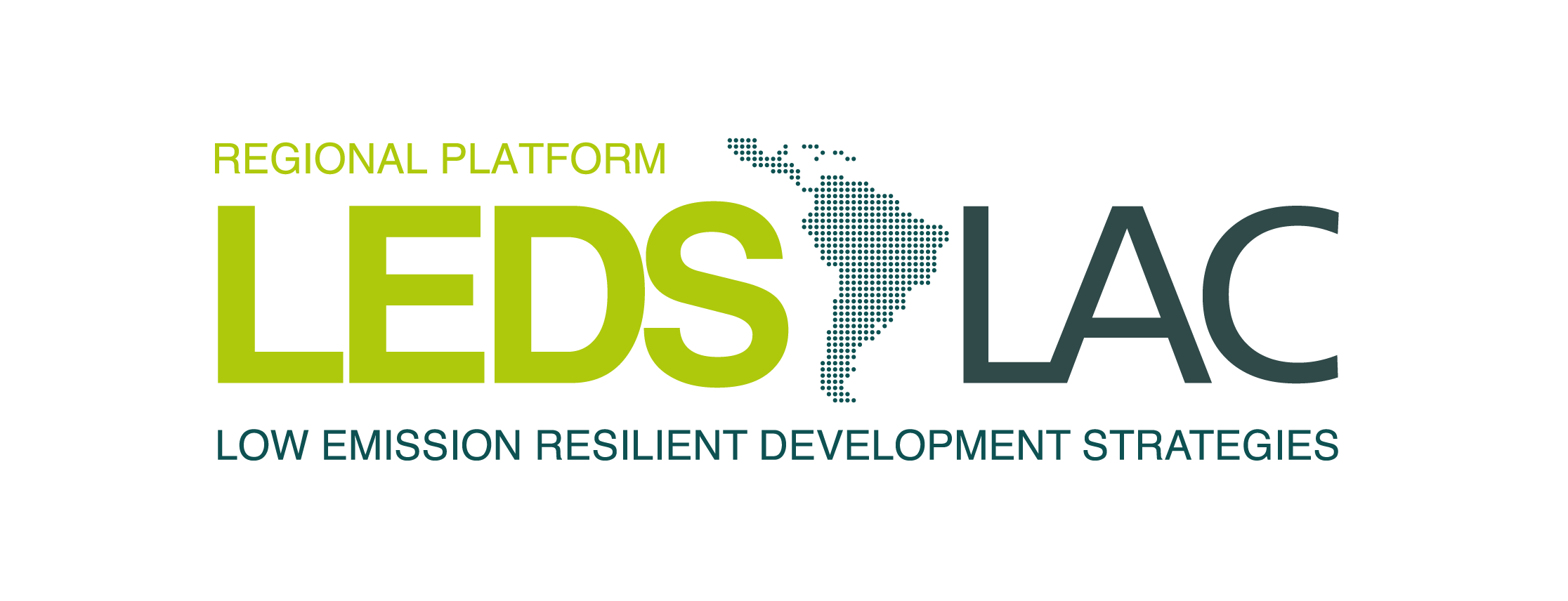
- June 22, 2021.

On Thursday, June 10, the peer-to-peer exchange session ".ICAT methodologies for transformational change and sustainable development: monitoring progress towards global goals". organized by the LEDS LAC platform together with the UNEP DTU Partnership (UDP) in the framework of the Initiative for Climate Action Transparency (ICAT). The objective of the session was to present the conceptual framework, applicability and examples from the region of both the ICAT methodologies of Sustainable Development and Transformational Change. The presentation was followed by a reflection with the attendees on the applicability and barriers of the methodologies. Mirko dal Maso from UDP presented the theoretical framework and the steps of both methodologies; and Felix Torres, ICAT consultant in Costa Rica, presented the implementation of the methodologies in a pilot of NAMA waste in Costa Rica. This in-depth session represents the continuation of the webinar on the same subject held on Thursday, March 25, 2021
Within the framework of meeting global climate objectives, ICAT has developed a series of policy evaluation guidelines among which the following can be found Transformational Change Methodology (CT) and the Sustainable Development Methodology (SD). The value of these methodologies lies in their ability to develop and implement effective policies, to integrate stakeholders (horizontally and vertically) and to communicate results (nationally, internationally or for access to finance). Climate actions can be understood as catalysts for development and as such have synergies with sustainable development which, maximized by counterbalancing trade-offs, can contribute trans-firmly to meeting global objectives.
The objective of the SD methodology is to analyze the positive and negative impacts of climate actions in relation to sustainable development criteria in order to maximize the positive and minimize the negative. It should be noted that the methodology is not a calculation or modeling tool but a systematic framework to assess the effects of actions or policies, adaptable to different country contexts, type of organization or other contexts. On the other hand, the TC methodology aims at assessing the transformational change of a policy or action based on the analysis of the processes and results The evaluation of transformational change is carried out by assessing the relevant characteristics, processes and results in terms of the initial situation and the expected situation. The evaluation of transformational change is carried out by assessing the relevant characteristics, processes and results in terms of the initial situation and the expected situation. The final aggregation of the assessments makes it possible to place within the transformational change assessment matrix which locates the action in terms of transformation potential, taking as axes the probability of change (processes) and on the other hand the result of change (outcomes). The results can be disaggregated by characteristics or aggregated for the whole action, as shown in Fig. 1.
ICAT defines transformational change as a fundamental and sustained change to a system that disrupts established high-carbon practices and contributes to a zero-carbon society in line with the goals of the Paris Agreement and the UN SDGs.

Costa Rica experience
Currently, in phase II of the ICAT-Costa Rica project, the SD and TC guidelines are being adapted to the national context and objectives, in order to incorporate the analysis of the guidelines for registering a mitigation action in the National Climate Change System, so that it will be possible to collect information on the social, environmental and economic impacts of the country's climate action. These adapted guidelines have been applied in three pilots to determine their applicability and identify any necessary modifications. One of these pilots was carried out in the NAMA WasteThe project aimed to reduce GHG emissions by 64% by 2032 through organic waste management and the promotion of responsible consumption policies. The results of the application of the methodologies are described below.
The application of the sustainable development methodology in the Waste NAMA was carried out in the following way ex ante as the project is still in the design stage. The first step was to identify a list of impact categories (e.g. access to sanitation, improved quality of life, new business opportunities, job creation, GHG emissions mitigation, among others) which were short-listed through a prioritization process based on two main criteria: that they were aligned with the country's objectives and their relevance in terms of emissions mitigation. Then, in a participatory work with the members of the NAMA committee, the following were identified specific impacts such as reduction of collection fees, generation of municipal and private partnerships, development of capacities for selective collection, prevention of diseases, enabling conditions for green businesses, reduction of environmental impacts, among others. On the mapping of specific impacts, trade-offs and synergies with the 2030 Agenda were identified and with an additional weighting it was identified which SDGs were being impacted and at what level. Thus, SDG 12 on responsible production and consumption, SDG 14 on underwater life and SDG 5 on gender were identified as having the greatest impact. As a final step, monitoring is planned to accompany project implementation to follow up on impacts.
It is worth mentioning that this same exercise was repeated in two other pilots, the results being comparable and making it possible to identify those objectives on which different measures have different impacts.

On the other hand, the application of the transformational change assessment methodology was more complex because the guide is more abstract. The characteristics of transformational change suggested in the ICAT guide were taken and the most relevant to the pilot were prioritized (e.g., research and development; adoption; dissemination and expansion of coverage). Associated indicators were assigned to each of the characteristics, taking the following as primary criteria that are feasible to measure (e.g. number of supply and demand opportunities for recoverable waste published in the information system; reduction of tons of organic waste disposed of in landfills; number of technical assistance programs provided). With the criteria of the guide, it was possible to plot the characteristics of the process in terms of mitigation and SD. Thanks to the evaluation it was corroborated that the action is potentially transformational in both GHG emission reductions and SD.

The experience of applying the SD and TC evaluations in Costa Rica leaves some important lessons learned. It is a challenge to adapt and simplify the guidelines so that they are not only for the use of experts. On the other hand, the next steps are to make a future projection of expected impacts (number of jobs, income generated, etc.) and not wait for implementation to show results to stakeholders. The latter should also be involved in the identification of impacts in order to reach a greater level of depth. Furthermore, despite the simplification of the guidelines, they require time in their application, so it would be feasible to institutionalize the process.
Finally, in conversation with participants from countries in the region, additional elements were discussed, such as:
- Having a long-term vision in government planning bodies is a challenge, since the scales of projections are normally limited to administrative periods. The guides provide methodological support to overcome this challenge.
- The flexibility of methodologies to adapt the application of assessments to different contexts (e.g. government, private sector) and scales (national, sub-national) opens up different opportunities for climate action planning and mainstreaming with development objectives.
- The availability and accessibility of quality information from different sources, scales and levels is identified as a critical factor. In this sense, not having this information is recognized as a common barrier to the application of the methodologies.

About LEDS LAC
LEDS LAC is a platform for collaboration and action, driven by Latin American and Caribbean countries, to support the implementation of LEDS and NDCs, increase the ambition of emission reduction and adaptation targets, and define medium and long-term strategies, with a vision of a resilient and low-emission region.
LEDS LAC is the regional platform for Latin America and the Caribbean of the Low Emissions and Climate Resilient Development Strategies Global Partnership (LEDS GP). Launched in 2012, LEDS LAC operates under the general principles of LEDS GP, has an independent Steering Committee formed by representatives of international organizations, governmental institutions and NGOs from the region, and a Secretariat operated by Libélula - Climate Change Management and Communication, from Peru.
About ICAT and UDP
There is a growing demand for climate transparency information in Latin America and the Caribbean (LAC). With the approval of the Katowice rules at COP24, several countries in the region have sought to strengthen their reporting systems with international support. The Climate Action Transparency Initiative (ICAT) has been one of the most active initiatives in this area. ICAT's mission is to help countries better assess the impacts of their climate policies and actions, and to help them achieve their climate commitments. In this way it aims to contribute to greater transparency, effectiveness, ambition and confidence in global climate action. To date, ICAT has developed a varied toolbox of methodologies and tools for this purpose; and in LAC, ICAT projects have been implemented in Argentina, Chile, Colombia, Costa Rica, Cuba, Dominican Republic, Ecuador, Mexico and Peru. For its part, the UNEP DTU Partnership (UDP) has been involved since the beginning of the initiative as a leader in the execution of ICAT projects in the countries, assuming coordination roles, providing technical assistance and coordinating activities to improve technical exchanges between countries.
